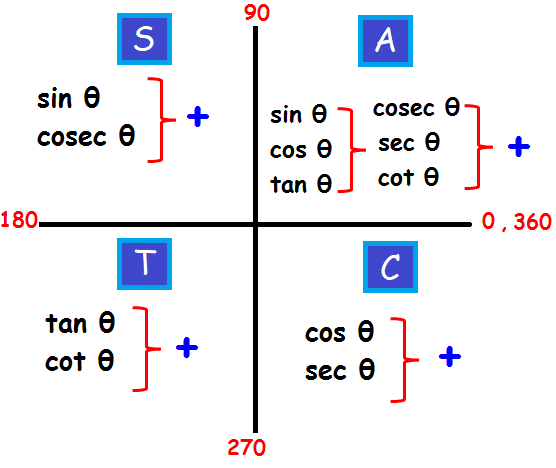

So just remember draw a diagram, identify the reference angle, find the tangent of that reference angle and then use the quadrant to decide whether the tangent's positive or negative. A good way to remember this is by saying All Students Take Calculus. So tangent's negative here and that means tangent of root 3 over 4 is -1. It is also important to know which functions are positive and negative in each quadrant. We're in the second quadrant right now, where only sine is positive. And you have to remember the mnemonic all students take calculus.
#All students take calculus cosecant plus#
It's plus or minus depending on which quadrant you're in. Once you've got that, the tangent of 3 pi over 4 is either plus or minus this value. That's our first quadrant angle and its tangent is 1. You want to take the tangent, the tangent of that angle. Once you've identified the reference angle then you want to take, oops. Now the reference angle is the angle between the terminal side and the x axis. The second step is to identify the reference angle. For example find the tangent of 3 pi over 4.
#All students take calculus cosecant how to#
And I want to show you how to find values of tangent in other quadrants. Other experts point to the need for schools to create a sense of belonging for Black and Latino students, in particular, in advanced math courses in tandem with eliminating systemic barriers such as strict course prerequisites.Okay, we just learned some basic values of the tangent function in the first quadrant. “However, if administrators, heads of math departments or whatever, if they incorporate this and enhance the tracking, and use it as a gatekeeper course then it’s not going to solve the problem.” “This is an opportunity to better prepare diverse groups of students that have historically been underrepresented to give them this access, if they choose to do that,” Mims said. Students of color and students from low-income families are also less likely to begin high school on an accelerated math pathway due to teacher perceptions of their abilities, Mims added. For example, a student getting a B-minus in a precalculus honors course might not qualify for AP calculus in some schools. Below you will see the ratios formed by these functions. He noted that schools that serve students of color and students from low-income families often don’t offer AP calculus courses and so AP Precalculus could fit into schools’ existing catalog of courses as an alternative high-level option.īut that also means schools need to ensure these students are able to enroll in AP Precalculus, and not be tracked out of it by rigid recommendation processes that often exclude students from advanced classes. tangent (tan), cosecant (csc), secant (sec), and cotangent (cot). So while some students may take AP Precalculus their junior year as a precursor to AP calculus, others can take the new course their senior year more generally as a precursor to college-level math.Īnd if implemented correctly, the new AP course can help address the disparities of representation in advanced math courses, Mims said. AP Precalculus can serve as a senior year capstone course that can better prepare students to take calculus in college, avoid remedial classes, and in some cases even offer course credit, said Mims, who served on the advisory committee for creating the new AP course.

Some offer Algebra 1 in 8th grade, others in 9th grade, and others offer Algebra 2 as the highest level, said Adrian Mims Sr., the founder and chief executive of the Calculus Project, a program geared toward increasing the number of students of color and students from low-income families completing AP calculus.īecause of this variety, it can be difficult for some schools to properly prepare and support students’ transition into a calculus course their senior year of high school given the limited range of math courses they offer. There is currently a variety of ways in which schools organize math courses. Big disparities in opportunities for access to high-level math courses “We think it’s important that all students have an incentive to stay invested and interested in math throughout their high school career and make a successful transition to college or a promising career,” said Trevor Packer, the senior vice president of AP and Instruction for the College Board. It will cover a “broad spectrum of function types that are foundational for careers in mathematics, physics, biology, health science, social science, and data science,” according to the course framework. In an effort to better prepare all students for college-level math courses, the College Board will offer a new AP Precalculus course beginning in fall 2023.


 0 kommentar(er)
0 kommentar(er)
